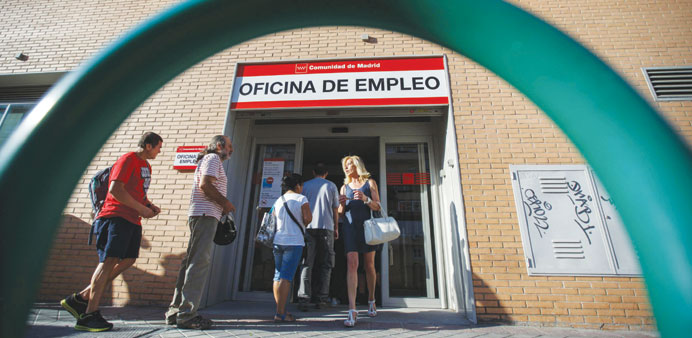People enter a government-run employment office in Madrid. A strong start to the tourist season helped Spain’s unemployment rate fall to its lowest in two years while two banks with large local customer bases said business had picked up, fuelling hopes the country’s economic revival is gathering pace.
Reuters/Madrid
A strong start to the tourist season helped Spain’s unemployment rate fall to its lowest in two years while two banks with large local customer bases said business had picked up, fuelling hopes the country’s economic revival is gathering pace.
With a minister suggesting the government might raise its GDP forecast, data showed joblessness – a millstone that has weighed on Spain’s growth hopes for six years – fell at the fastest quarterly rate on record between April and June.
“These (unemployment) figures are much better than expected and ... seasonally adjusted figures are also strong,” said Jose Luis Martinez, economist at Citi in Madrid.
“I have the feeling that there has been a very sharp halt in activity in the last two years, maybe more than is rational, and that’s starting to normalise the situation”.
Spain has been in and out of recession since a housing bubble burst in 2008, saddling its banks with billions of euros of soured property assets and loans and leavingmns of low-skilled labourers out of a job.
The crisis sent the unemployment rate from a low of around 8% in 2007 to a high of near 27% last year. Yesterday’s data from statistics institute INE showed the rate fell to 24.5% from 25.9% in the first quarter.
Spain’s unemployment figure remains the second highest in Europe, but the drop was the sharpest year-on-year since early 2006 – before the start of the financial crisis – and the extra 400,000 people that started jobs marked the largest quarterly boost to the workforce since 2005.
Jaime Guardiola, chief executive of mid-ranking lender Banco Sabadell, suggested prospects for the banking sector also looked brighter than at any stage since the crisis.
“The outlook, for the first time in seven years, is positive,” he told a news conference after the bank, and its smaller rival Bankinter, said net income from lending rose more than expected in the second quarter.
After years of painful fiscal adjustments and structural reforms, the eurozone’s fourth largest economy is expected to grow by over 1.2% this year and up to 2% in 2015, making it one of the strongest performers in the eurozone. The Bank of Spain raised its economic projections for this year and next on Wednesday.
Economy secretary Fernando Jimenez Latorre said the government could also revise its growth forecast when it prepares next year’s budget in September.
“Everything suggests that economic activity is speeding up and the revision will be upwards,” he told a conference.
Sabadell, Spain’s fifth-biggest bank by stock market value, said net interest income rose 32% from a year while it rose 18% at Bankinter.
Much of the rise was due to cheaper financing costs at the banks which - unlike their larger compatriots BBVA and Banco Santander - do the bulk of their business in Spain.
But there were also signs of an improved lending trends in a country where a credit crunch has been a big constraint on the economic recovery.
Sabadell’s credit to clients fell 2% year on year in the first half, but the decline was modest compared to recent years and the bank said there were signs of a turning point.
“June is the first month (in a long time) when the stock of credit to companies is positive,” Sabadell’s Guardiola said.
At Bankinter, lending rose nearly 1%. Both banks’ bad loans as a percentage of total credit fell at the end of June compared with end-March.
Stefan Nedialkov, analyst at Citigroup, said he expected the pattern to be replicated elsewhere.
“We expect to see better net interest income, provisions and non-performing loans ratios quarter-on-quarter at most Spanish banks,” he said.
Meanwhile, Spanish oil major Repsol posted forecast-beating second-quarter results yesterday, where numbers showed oil demand in the country stabilizing.
The second quarter tends to be a strong period of job creation as Spain’s vital tourist season begins, and it saw an extra boost this year with the busy Easter week falling in April.
But the seasonally-adjusted data were also positive, showing a 3.12% fall in unemployment from the previous quarter and marking the fifth straight quarter of falls, while employment rose 1.03%.
The quality of employment also improved, with 304,400 new jobs being full-time while 180,200 contracts signed were permanent ones.
Spain’s conservative government has said a 2013 labour market reform - which made it cheaper for struggling firms to hire and fire - is starting to bear fruit.
Javier Diaz-Gimenez, economist at IESE business school, said the reform helped firm react faster to the downturn and this was reflected in a return to labour growth as the economy picks up. “But, even so, unemployment levels are still unsustainable and crazy high.
Unemployment remains the main challenge for the Spanish economy, the main barrier to growth and Spain’s main disgrace,” said Diaz-Gimenez.



